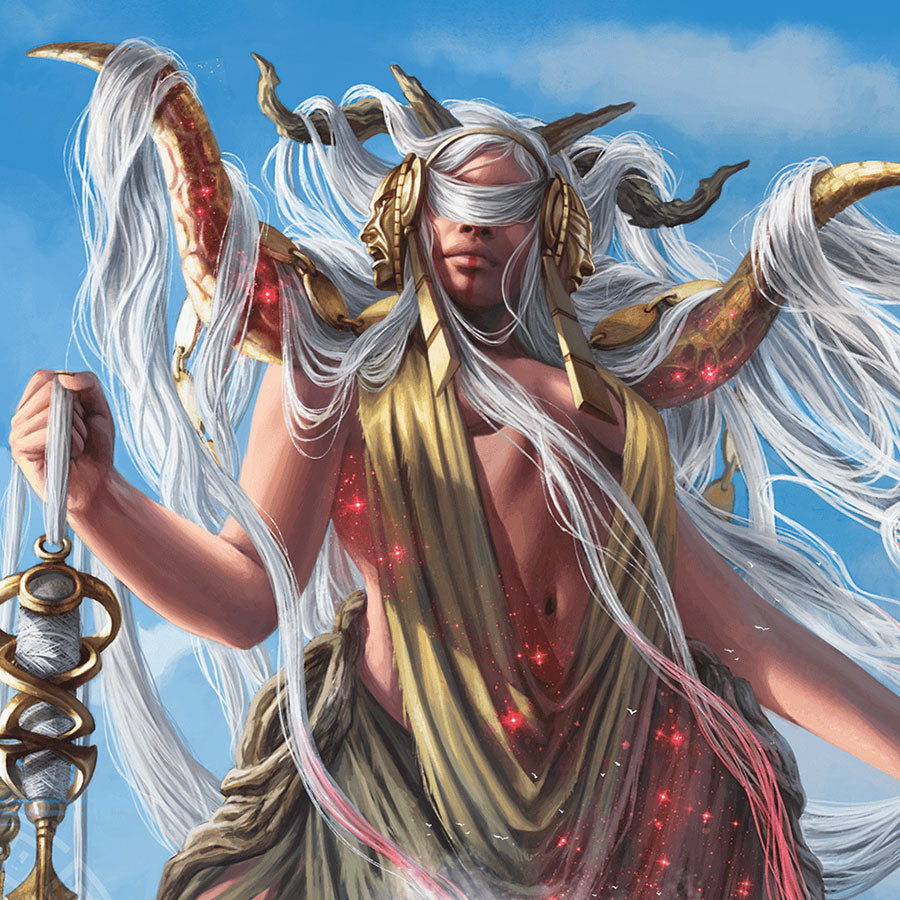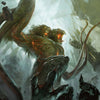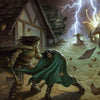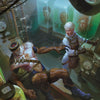You TPK’d, Now What? | How to Handle a Total Party Kill in D&D

Total party kills (TPKs) happen in tabletop RPGs. Whether your D&D players bit off more than they could chew, made a stupid decision, or you as the game master over-tweaked your Pathfinder 2 encounter, eventually you’re likely to experience a TPK in your game at some point or another. Or maybe your campaign has just been on hiatus for an extended period, and you looking to reboot it.
Either way, the question is: What do you do to keep the game going, get back in the saddle, and keep having fun with your friends?
Thus, today we discuss how a game master should handle a TPK or reboot in their TTRPG campaign.
By the way, if you’re looking for a low-level, fifth-edition adventure module, check out Into the Fey. It’s designed for levels 1 to 5 and features lots of new fey creatures and their tricksy plots. Pick up the Into the Fey Ultimate Bundle to get the hardcover, the PDF, digital maps, and digital tokens!
Watch or listen to this article by clicking the video below.
Step #1: The Discussion
The very first thing you should do after a TPK is discuss it with your players.
Moments like this can be heavy for lots of players. I know that even as a game master, when I have a TPK, I have some emotions going on, too. So, I’ve found that it’s something that really needs to be discussed. You can get things rolling with very simple questions. “What do you guys think happened there? Why do you think we TPK’d?” It’s important for everyone, players and GM, to be able to discuss this and break down the causes of the TPK. This can help folks sort through emotions, one, but also learn from the incident for the future.
And this doesn’t just mean the players, either. You, the game master, can learn a lot from these discussions. For instance, when we’ve had character deaths and TPKs in my Pathfinder 2 group, this discussion has helped me learn that severe encounters after the group has expended most of their resources can be devastating. And that in turn has helped my players learn that if they’ve blown their wad, they REALLY shouldn’t just press forward and hope it all works out.
You also want to know how your players are FEELING about the TPK. Ask them simple questions again: “How do you guys feel about the TPK? Are you upset, disappointed?” Part of what you’re doing here is just giving your players the space to express themselves and get their emotions out in the open. Some of them may be upset or sad about the TPK, and just expressing those emotions can be very helpful.
Please note: you don’t have to comfort or try to resolve any negative emotions your players express. You’re not trying to fix anything. You just want them to get the emotions out in the open because that alone many times helps them feel better. Also, make sure you are listening to them. People—human beings—just want to be HEARD and LISTENED to and UNDERSTOOD; and when they are, that often makes them feel better. And this all helps smooth over the sting of a TPK and allows you all to move forward.
Step #2: Where to Go from Here?
The next step after having the group discussion is deciding where to go from here. The players’ characters lie scattered around the dungeon floor, bodies cooling in pools of their own blood, and the bad guys are feasting, celebrating their demise. Meanwhile, the Big Bad of the campaign continues plotting, continues doing vile unspeakable horrors.
Do your players create new characters at the exact same level and pick up where things left off? This, by the way, is my preferred approach, and it’s one that players often prefer. It has the advantage of adding little extra work to the GM, and the players get the satisfaction of not only continuing the campaign where they left off, but they also don’t have to go through the entire leveling process again. Resetting back to level 1 or 3 or whatever after a TPK can make your players feel even worse because they’ve lost all that leveling progress. And it adds more work to you, the GM. So, if your players are going to make new character at the same level and just keep going, they could create them right then and there together, especially if you still have a few hours left in the game session.
And then you as the game master just need to decide how to get their new party plugged back into the campaign. It’s cool, you have time while they are making new PCs—unless you’re drawing skulls all over their old characters sheets, laminating them, and placing them in the “PC Grave Binder” you keep on the top shelf. But no, like who does that?
Anyway, your options are varied. The new party can literally get the same mission from the same quest giver who reaches out to them after the old party doesn’t return. Or the party hears of the demise of another adventuring party—one that had quite a few magic items and other booty on them—and decides to chase down their payday. Along the way, they learn of the larger campaign conflict and get caught up in it.
Fun fact: when I’ve had TPKs, my players have gotten REALLY excited about recovering the bodies and the loot—you know, because they had lots of really cool stuff and they want it back. Another fun fact: the bad guys usually take it, too, and are using it themselves, which makes things a big spicier… And, sometimes, their loot isn’t in the same location anymore. Life isn’t always convenient, is it?
At any rate, there’s limitless ways you can plug the new party into the current campaign. One thing you can do, especially if you’re having a rough time figuring out a good way to implement it, is simply ask your players how they’d like their new party to get looped back in.
Of course, you and your players may decide that they want to start with fresh players at level 1 or 3 or wherever you all like to start. In that case, they can get cracking on that, and you all just need to decide whether you’re going to continue the same campaign with the same overarching plot lines, or whether it’ll be something fresh.
And, by the way, this is totally a conversation you should be having with your players. Like, this whole discussion of what to do after the TPK is one to be had with your players. Ideally as a group you will all decide and agree upon what you’d all like to do. Now, my money is on players wanting to start at the same level with new PCs, but every so often folks do want to start over at low levels. If the plotline and Big Bad will all be the same, you basically need to redesign your adventures and the flow that will lead the new low-level party to that final confrontation. However, it doesn’t mean you need to do it by yourself, though you certainly could.
But as an alternative approach, you could tell your players that their characters have heard about the problems in the region and how a much more powerful party just perished trying to resolve them, and that it now falls on them, green as they are, to step up and get ‘er done. Then you can ask your players how THEY might like to approach resolving the issues they’ve heard about. Then, based on their ideas, you can design adventures and scenarios. This has the added benefit of getting them INVESTED in the adventures and giving them ownership over them. This will help a ton with engagement.
Also, if you are going to start over at level 1 and the group decides to start fresh with a new campaign, this might be the perfect opportunity to try out a new game system. Maybe 5th edition is getting stale, and you want to try out Pathfinder 2 or Dungeon Crawl Classics or Castles and Crusades. A TPK is a great opportunity for that!
What Not to Do
Okay, now we’re going to discuss some other ways to handle a TPK that I personally dislike—and I’ll tell you way, of course—but you are not me, and your group of players is not my group of players, so it’s quite possible that some of these options will appeal to you and your players.
“You’re not dead, just captured.” This approach basically goes like this: regardless of what actually happened, the party didn’t die. Instead, the enemies captured them. From there, you have a couple options. First, the captured characters wake up as captives in their cells and have to figure out how to escape. Or second, the players still roll up new characters, and they have to perform a rescue mission. Then, assuming they succeed, each player can choose which character they’d like to keep playing, the old one or the new one.
Now, full disclosure: I have actually done this before, but ONLY because it made sense for the enemies to capture them instead, and frankly, when I was designing the adventure, I was PLANNING for the possibility of them being captured because they were going up against enemies that were way too powerful for them. However, I would never do this if the characters were actually dying—like we’re doing death saves, they fail them all, or they receive catastrophic damage and are outright killed—like, I’m not going to invalidate the facts of what actually happened at the game table. However, if they didn’t die, and the enemies might actually have a reason to keep them alive—interrogation, leverage against the city, etc.—then I think this is a fine route to take.
“That’s just one way it might have happened…” This approach entails essentially restarting the clock to before the encounter, before the TPK, and giving the players another go at it, another chance to overcome the encounter and not TPK. This might mean another combat, or it might mean avoiding the situation or using social skills. Any way you slice it, it’s basically reloading at your last save point.
Frankly, this approach goes against almost every reason that I play tabletop RPGs to begin with. It breaks immersion. It breaks verisimilitude. It makes victory meaningless because we’re basically just getting participation trophies and victory is all but assured; like you can’t lose, just try again. No, I can’t stomach this approach. If my character died, fine, he died. I’ll make a new one. But don’t put your kids gloves on, pat me on the head, and say, “It’s going to be alright Jonny, we’ll just reload the game.”
No thank you. If death and defeat isn’t a possibility in my TTRPGs, I’d rather not play. But that’s just me. You might feel differently, and that’s okay. The beauty of these games is that there is more than one way to do things, and my way may not be the right way for you. We all have our own personal preferences.
Campaign Reboot | Coming Back from an Extended Break
Now, if your group has been on hiatus for awhile and you want to get things going again, these are the steps to follow.
First, reach out to your players and see who’s still on board. If you need to find new players, do so. If you need help doing that, we have an LFG channel over on the DM Lair Discord server where lots of folks find groups and new players. You could check that out.
Next, determine a reoccurring time to play. This seems like common sense, but hear me out. The NUMBER ONE reason groups fall apart is because of scheduling issues—people get too busy, they start missing sessions, the GM starts cancelling or rescheduling sessions…it’s a death spiral. You’ve probably experienced that yourself, haven’t you?
So, this is the number one piece of advice I can give you for setting up your game schedule for success: Pick a day of the week and time for the group to play when folks are generally available, and set the occurrence for every two weeks. My Thieves Abound Pathfinder 2 group plays every other Sunday at 4 pm, for instance. Every two weeks is a great frequency for a variety of reasons that I’ve talked about before, so I won’t go into it here.
HOWEVER, here is the most important part: when a player can’t make a session, you DO NOT reschedule or cancel the session. That is the very thing that often leads to the scheduling spiral of death. No, don’t go there. Just have the game as normal and that one player just misses out. If you’re dead set on everyone being there, then accept that you’re going to frequently not play and your group is probably going to fizzle out again. I have delved into the psychological reasons for not canceling and how it actually IMPROVES attendance before, but it’s a thing.
Now that you have the playdate scheduled—aw isn’t that cute, we have playdates as adults—your next step is to determine HOW to get the campaign back up and running. And many of them are the same options as recovering from a TPK.
They are picking up the campaign where you left off with the exact same characters, or with NEW characters, though at the same level. Or you might have the same campaign concept, but the players make new low-level characters and you approach things from a fresh perspective. Of course, you can always just start a brand new campaign with new characters, too. My recommendation is discussing with your players and seeing what you all are most interested in.
A 5e Adventure Module Filled with Fey Creatures and Their Tricksy Plots!
If you’re looking to start up a new 5e campaign or reboot your current one, Into the Fey may be exactly what you need. Designed for levels 1 to 5, Into the Fey contains everything you need to start playing:
- 11 fey-themed adventures
- over 40 new fey creatures
- the fully fleshed-out starting town of Aeredale
- regional information and maps for both the material and fey planes
Pick up the Into the Fey Ultimate Bundle to get the hardcover, the PDF, digital maps, and digital tokens.
Starting a new campaign can be tons of work; let Into the Fey do some o\f the heavy lifting for you!
-
Posted in
Game Master How-To Articles







